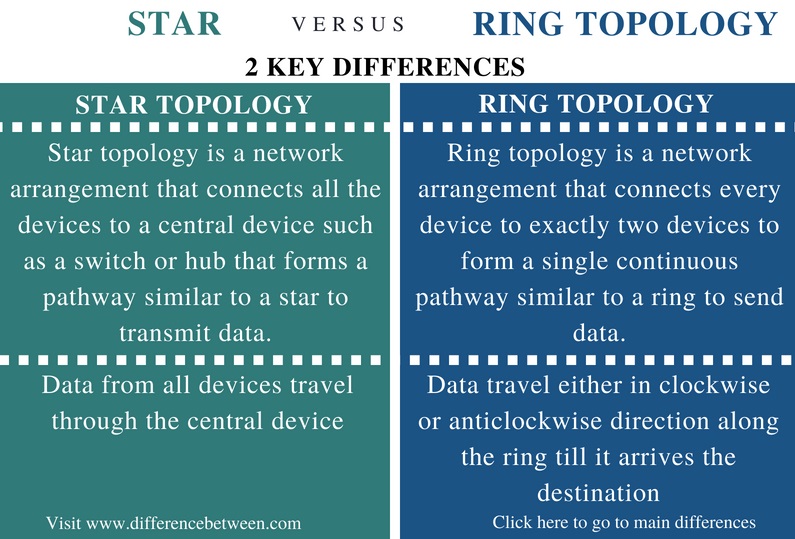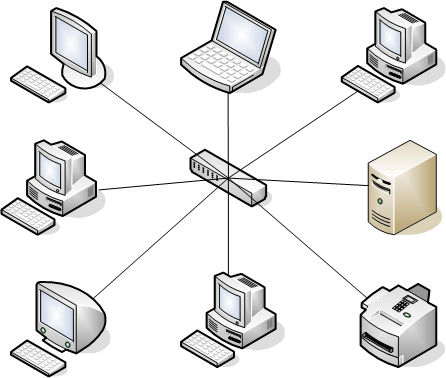The key difference between star and ring topology is that the star topology connects all devices to a central device forming a pathway similar to a star while ring topology connects every device to exactly two devices forming a single continuous pathway similar to a ring.
There are many devices in a computer network. The network topology is an arrangement of connecting various devices in the network. These network topologies can be bus, ring, star, tree, or mesh. There can also be a hybrid that consists of two or more of the above topologies. This article discusses two common topologies which are star and ring.

CONTENTS
1. Overview and Key Difference
2. What is Star Topology
3. What is Ring Topology
4. Side by Side Comparison – Star vs Ring Topology in Tabular Form
5. Summary
What is Star Topology?
In the star topology, there is a connection between every device in the network to the central node. The central node is a device, which can be a switch or a hub. Further, the connections can be via twisted pair cables or coaxial cables.

Figure 01: Star Topology
The main advantage of the star topology is that it is easy to troubleshoot. Moreover, if one device fails, it will not affect the communication of the other devices. Therefore, it is easy to replace that faulty device with some other device. It is also easy to setup and modify the network. Furthermore, as there is only one central device, it is simple to upgrade.
Although it has many advantages, there are few drawbacks too. Information from all devices passes through the central device. Therefore, if the central device fails, the entire network fails. Another point is that the performance of the network highly depends on the central device. However, in overall, this topology is easy to install and manage and is ideal for home and office networks.
What is Ring Topology?
In a ring topology, the connections are sequential. The first device connects to the next in the ring and so on, and the last device connects back to the first device; thus forming a ring-like structure. Therefore, every device has two neighbouring devices. Each device receives messages from the previous device and sends it to the next device. Data flows through the ring either in clockwise or anti-clockwise direction. The message passes around the ring until it reaches the destination device.

Figure 02: Ring Topology
Ring topology is cheap to install but not in wide use due to the difficulty in maintenance. Further, a failure in one device can affect the communication of the entire network. Moreover, the process of adding and removing the devices from the network is complex. Therefore, it is difficult to do troubleshooting in a ring topology.
What is the Difference Between Star and Ring Topology?
Star vs Ring Topology | |
| Star topology is a network arrangement that connects all the devices to a central device such as a switch or hub that forms a pathway similar to a star to transmit data. | Ring topology is a network arrangement that connects every device to exactly two devices to form a single continuous pathway similar to a ring to send data. |
| Architecture Structure | |
| Each device connects to the central device | Each device connects to two other devices |
| Data Transmission | |
| Data from all devices travel through the central device | Data travel either in clockwise or anticlockwise direction along the ring till it arrives the destination |
| Effect of Failure to Network | |
| Failure in the central device will cause the entire network to fail. Failures in other devices will not affect the network as long as the central device works. | Failure in one device will cause the entire network to fail |
| Troubleshooting | |
| Easy to troubleshoot. | Difficult to troubleshoot |
| Cost | |
| Implementation is expensive | Implementation is cheaper, in comparison |
Summary – Star vs Ring Topology
Star and ring are two computer network topologies. The difference between star and ring topology is that the star topology connects all devices to a central device forming a pathway similar to a star while the ring topology connects every device to exactly two other devices forming a single continuous pathway similar to a ring.
Reference:
1.“CCNA – Bus, Ring, Star & Mesh Topologies.” CertificationKits.com. Available here
Image Courtesy:
1.’Star Topology’By Umapathy – Own work, (CC BY-SA 3.0) via Commons Wikimedia
2.’Ring Topology’By अरविंद धरेप्पा बगले – Own work, (CC BY-SA 4.0) via Commons Wikimedia
ncG1vNJzZmivp6x7pbXFn5yrnZ6YsqOx07CcnqZemLyue8OinZ%2Bdopq7pLGMm5ytr5Wau26%2F05qpZpmemXqztc2gZK2noKS5sLPYaA%3D%3D